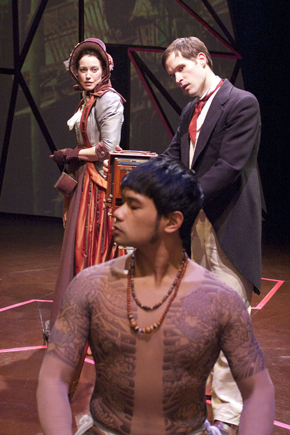
He is a Japanese ricksha driver, his body tattooed in blue and green and purple, and we can't take our eyes off him. This is because the other two characters onstage—a Gilded-Age American matron and a sybaretic expatriate photographer—are likewise riveted by his exotic body decoration, their shared curiosity drawing our gaze in his direction. Since we in 2013 are less unnerved by the notion of living flesh as a canvas, we soon notice that only his torso and thighs are covered in the colored inks, even as we later gasp at the sight of a huge tattooed black rose worn like a cloak on a native girl's bare back.
Before the end of Naomi Iizuka's Concerning Strange Devices From the Distant West, though, the question will cross our minds, "Is that real, or do they paint it on every night?"
It takes four artists to answer this provocative query. The process began before the start of rehearsals with Nan Zabriskie, credited in the playbill as "Tattoo Technical Consultant," and her research into the technologies for reproducing tattoos onstage, after which her findings were evaluated by the production staff in terms of time, labor, budget and actors' allergies.
"His legs are painted, but that's a body suit Kroy is wearing on top," says Associate Costume Designer Ricky Lurie, speaking of Kroydell Galima, who plays the nearly-naked ricksha driver, but also a modern-day art dealer dressed in a shirt with short sleeves, open collar and no visible skin art. "It's not because he has to appear without them in other scenes, but because it would have taken eight hours every night to do all of it by hand."
How are the patterns kept the same from night to night? "We experimented for several weeks before a local tattoo parlor suggested that it would be quicker, cleaner and easier to adapt existing designs in the creation of our graphics and then apply them with transfer paper from the shop—the way they do a tattoo before inking it in."
Once the pictures are in place, it's the job of Janet Howe and Austin Pettinger to color them in for each performance. "Kroy has about ten transferred images on his legs," Howe reports, "He has to stand perfectly still for two hours while I paint them in and Austin fills in the spaces between. Tiffany [Villarin]'s rose is all completely free-hand, however—Austin does it all."
Are audiences impressed? Howe laughs, "During the talk-backs, people are always asking if the tattoos are real. Kroy and Tiffany sometimes threaten to say, 'Why, yes, the tattoos are real—that's why I was cast'—but they're only joking."
"Actors also have to be careful offstage," Zabriskie adds, "I recall another show where an actress whose role required fake gang tattoos had to dress in sweaters every day to hide them from the teachers at her daughter's nursery school!"
"Kroy and Tiffany are great troupers, arranging their schedules to come in the afternoons, but Austin and Janet have the application process down to a science," Lurie observes, "The backstage action is almost zen-like."
Concerning Strange Devices From the Distant West runs at Timeline Theatre through April 14.
Mary Shen Barnidge
Contributing Writer

 Follow Us On Twitter
Follow Us On Twitter